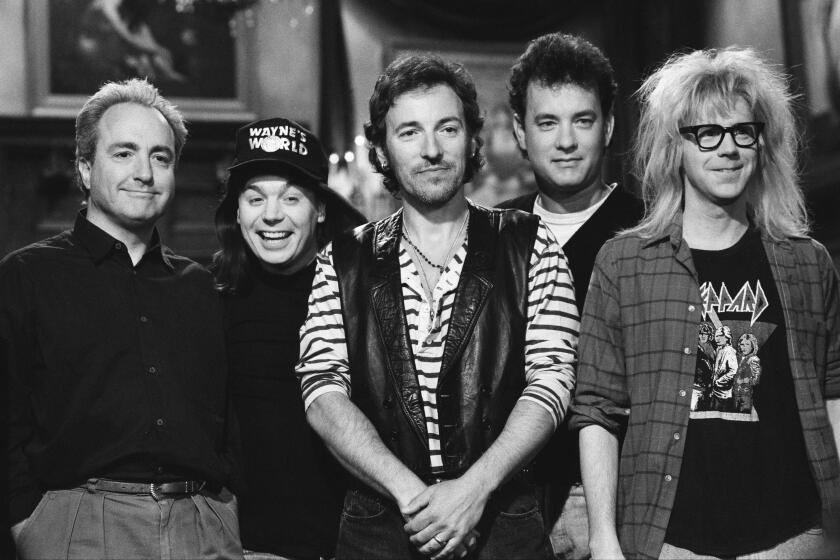Cut loose in the cosmos
- Share via
MORE than any other American writer, Robert Stone is a product of the 1960s -- or maybe it’s just that he was everywhere. Although he began the decade in New Orleans, his counterculture roots go back to Beat-era Times Square, where his wife, Janice, worked at the Seven Arts coffee shop, a meeting place for Jack Kerouac, Allen Ginsberg and Herbert Huncke. Later, Stone moved to Northern California as a Wallace Stegner fellow at Stanford University and became part of Ken Kesey’s circle at his La Honda compound in the hills near Palo Alto; he also spent time in Mexico, Hollywood and London, eventually becoming (to borrow a phrase from his 1975 novel “Dog Soldiers”) a “journalist of sorts” in Vietnam during the waning days of the war.
For Stone, however, the 1960s were not a Technicolor dreamscape but an abyss of moral ambiguity, indistinct and dangerous, a defining legacy of which has been the tendency to fool ourselves. As he suggests in his memoir, “Prime Green: Remembering the Sixties”: “Those of us who cared most deeply about the changes, those who gave their lives to them, were, I think, the most deceived.... Curved, finned, corporate Tomorrowland, as presented at the 1964 world’s fair, was over before it began, and we were borne along with it into a future that no one would have recognized, a world that no one could have wanted. Sex, drugs, and death were demystified. The LSD we took as a tonic of psychic liberation turned out to have been developed by CIA researchers as a weapon of the cold war. We had gone to a party in La Honda in 1963 that followed us out the door and into the street and filled the world with funny colors. But the prank was on us.”
“Prime Green” is Stone’s first work of nonfiction, an opportunity, as it were, to get a glimpse behind the curtain of his novels. Opening in the late 1950s, the book continues, in fits and starts, through his 1971 reporting stint in Vietnam. If this makes for a broad definition of the decade, it’s only appropriate, for history rarely fits the neat categorizations of human time. Rather, events have precedents, consequences; they grow out of one set of circumstances and into another, a loose chain of experience understood in retrospect, if at all. For Stone, that’s one of the points here -- the notion that memory is not orderly but kaleidoscopic, and meaning is what we bestow. “It’s so long now that I have only fragments of recollection,” he writes, “river mists, magnolia, gardens enclosed in old stone.”
Indeed, he reminds us, there is no way to encompass reality even in a memoir, only the chance to circumscribe a shadow territory between fact and myth. “I decided,” Stone explains, “ ... that between ‘realism’ and formalistic experiment there was no substantial difference. Originality was always welcome; experiments worked or they didn’t. Language was language and life was life, one tracking, undermining, enlightening the other.” That’s a telling statement, offering insight into his sense of what exactly literature can do. The truth is elusive, and the best we can hope for is to frame a story that makes sense to us. All else is folly, false impression, the illusion of a self-deceiving mind. Or, as Kesey puts it, in one of the book’s most trenchant comments: “If you’ve got it all together
Kesey’s prankster persona drifts through much of “Prime Green” like an animating spirit -- although, to his credit, Stone sees it for what it is. His account of the Merry Prankster era and its aftermath (in which Kesey faked his suicide and fled to Mexico to avoid prosecution on drug charges) is compelling not because Stone has anything new to tell us but because he recognizes the peculiar mix of hope and desperation that made the time what it was.
Unfortunately, the rest of the book lacks this focus; it’s meandering, even dull. Part of the problem is that, despite Stone’s presence at scenes ranging from the legendary Acid Tests to military briefing rooms, from Paul Newman’s production office to the Beatles’ Savile Row headquarters, he was never much of a joiner but someone who held himself apart. This, of course, is the key to his fiction, which revolves around loners and outcasts, cut loose in a cosmos they can’t define. In that sense, it’s hardly surprising that the best bits here are the interior observations, such as the description of sunrise over Mexico’s Manzanillo Bay from which the memoir draws its name: “In the moments after dawn, before the sun had reached the peaks of the sierra, the slopes and valleys of the rain forest would explode in green light, erupting inside a silence that seemed barely to contain it.... We called that light Prime Green; it was primal, primary, primo.”
More often, though, Stone seems not quite clear on his intentions, writing in a kind of shorthand that makes “Prime Green” read more like a glorified daybook than a fully realized work. Most problematic is his insistence on apologizing, at length, for “WUSA,” the 1970 film made from his 1967 debut novel “A Hall of Mirrors.” It’s as if in turning the lens on himself he can’t see beneath the surface of his experiences to get at the elusive inner life.
Here we have the issue in a nutshell. Over the past 40 years, Stone has staked his career on precisely the nuances “Prime Green” is lacking, framing the human condition in bleakly existential terms. The best of his fiction -- “Dog Soldiers,” “A Flag for Sunrise,” the magisterial “Damascus Gate” -- is informed by a fierce and unrelenting moral vision, the sense that we live not in a godless universe but one in which God has abandoned us, leaving an emptiness for which there is neither comfort nor redress. This, Stone’s novels mean to tell us, is the source of all our trouble, be it sectarian squabbling or dissolute soul-searching, none of which can ever be resolved. These are the roots of our deep divisions, our endless dissatisfactions, our inability to recognize each other or ourselves.
It’s a sensibility worthy of Conrad or Dostoevsky (both of whom Stone has cited as influences), one that speaks to the very essence of modernity, to our growing alienation from the world. Yet with “Prime Green,” Stone backs away from such complexities, offering commonplaces as opposed to questions, anecdotes that never add up to anything larger than themselves. That may well be how memory works, but there’s a difference between memory and memoir, which requires not just recollection but reflection, a perspective and a point of view.
To be fair, this could have something to do with genre; Stone is a novelist, after all. His 1997 short fiction collection, “Bear and His Daughter,” failed because he was not as adept in a compressed form as in the novel’s expansive whirl. More troubling, though, is that Stone’s most recent novel, “Bay of Souls,” suffered from similar difficulties, glib in places, superficial, indistinct. At the time, this seemed an anomaly, but “Prime Green” makes me think again. “Life,” Stone writes, “sometimes can be subsumed in magic, although the supply is not inexhaustible.” The same, I’d suggest, can be true of literature. *
More to Read
Sign up for our Book Club newsletter
Get the latest news, events and more from the Los Angeles Times Book Club, and help us get L.A. reading and talking.
You may occasionally receive promotional content from the Los Angeles Times.








